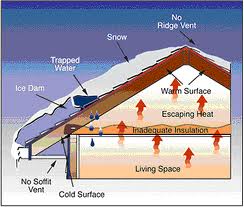Here comes the Polar Vortex again! And it’s causing havoc to buildings and roofs all over the country this year. So much for Global Warming!! Here are some facts and fiction about our new friend, the ice dam.
Fact: You can see ice dams from the ground. It’s true that you can usually spot a monster very easily, but not always. You can see the 4 foot icicles and the little glacier on your gutter. The sneaky ones are usually above skylights or in roof pan areas far out of sight. Sometimes ice dams grow up valleys and on top of dormers making it almost impossible to identify from the ground.
Fiction: When it comes to insulation, the more the better. Improperly insulated homes are just as bad as under insulated homes when it comes to ice dams. Specifically, insulation is frequently found done in such a way as to inhibit proper ventilation. If you don’t address air leakage into the attic or rafter spaces, all the insulation in the world won’t prevent ice dams.
Fact: Ice dams can occur with virtually no snow on your roof. It’s a question of ice accumulations. It takes very little actual moisture to form ice dams. Even a dusting of snow can create a problem. Of course it is most often the case the thick snow accumulations create ice dams more quickly.
Fiction: Gutters have something to do with ice dams. The truth is gutters have nothing whatsoever to do with ice dams. If your home is prone to ice dams you will get them either way. If you have gutters they will fill with ice and provide a foundation for the ice dam above. If you don’t have gutters, the ice dam simply builds on the cold edge of the roof. We provide ice dam removal for many homes each year that do not have gutters.
Fact: Gutter systems can be damaged by gutter ice. A section of otherwise fine gutter is either on the ground or hanging pathetically off the edge of the roof, filled with ice. Fresh water ice weighs about 60 pounds per cubic foot and gutters are not designed to tolerate that sort of load. It’s important to initiate gutter ice removal sooner, then later.
Fiction: Ice melting agents are the way to go. Using melting agents like rock salt, sodium chloride, calcium chloride, magnesium chloride but all present risks you should keep in mind. Some of the chemicals may affect the integrity or color of your roof, some are corrosive to the aluminum when gutter ice is removed this way, some are corrosive to valley metal and other flashings, some damage plant life as the water drains below. Could be adding salt to the wound (no pun intended)
Fact: Ice should be removed by steam. Roofers have fixed hundreds of roofs that have been damaged by well-intentioned professionals with hammers, picks and hatchets in their pursuit of removing ice dams to help their clients. The damage found caused by the less-than-professional souls is almost funny if it wasn’t so serious. Removing ice dams with picks and hammers can be done successfully. It’s boils down to a question of risk management. Roof Ice and Gutter Ice should always be removed with steam.
be removed by steam. Roofers have fixed hundreds of roofs that have been damaged by well-intentioned professionals with hammers, picks and hatchets in their pursuit of removing ice dams to help their clients. The damage found caused by the less-than-professional souls is almost funny if it wasn’t so serious. Removing ice dams with picks and hammers can be done successfully. It’s boils down to a question of risk management. Roof Ice and Gutter Ice should always be removed with steam.
Fiction: Ice dams need to be thick to cause a problem. Ice dams as thin as one inch can cause big problems. A good general rule is that the steeper your roof, the thicker the ice dam has to be to cause problems. On lower pitched roofs even a thin ice dam can hurt.
Fact: The leaking caused by ice dams may not show up right away. It would be nice if water stains or mold manifested immediately upon entering your home but it simply does not work that way. Often the water that ice dams push into homes travels around wall and ceiling cavities, trapped by vapor barriers and other materials until it finds the path of least resistance to escape. By the time you see water inside, it’s usually been there for a while. If you see staining it’s a good idea to call a home inspector to test for moisture and or mold before the late spring a summer heat turn your walls or ceilings into a lab experiment.
This article was written by Kevin Michaels Owner/Inspector of Hudson Valley Property Inspections, llc. HVPI offers moisture testing, indoor air quality sampling and mold inspections 7 days a week in the entire Hudson Valley area of New York.